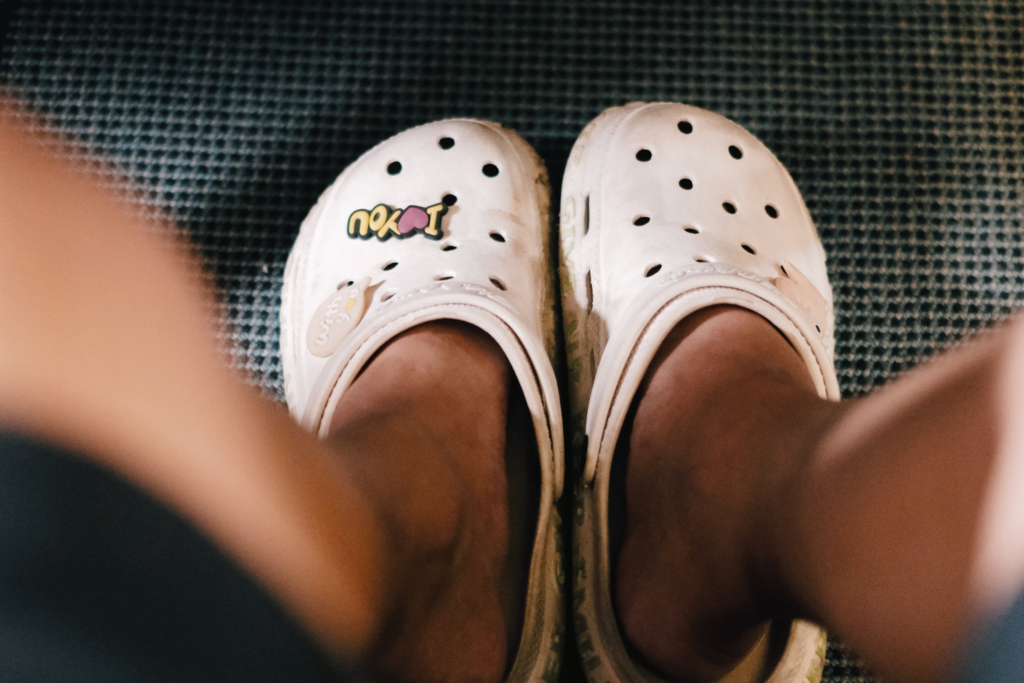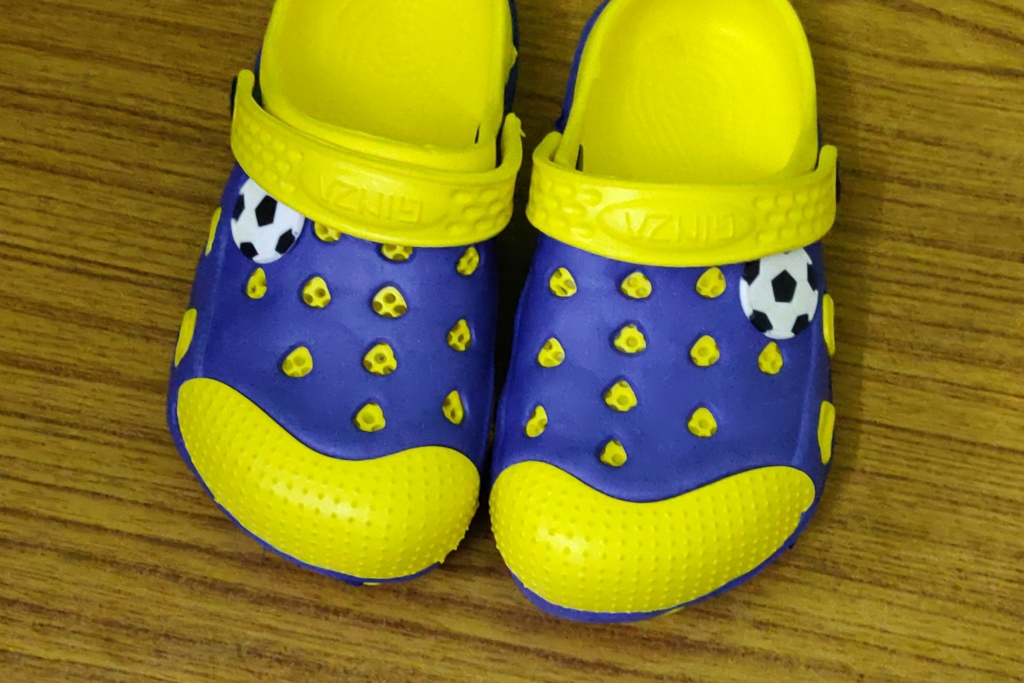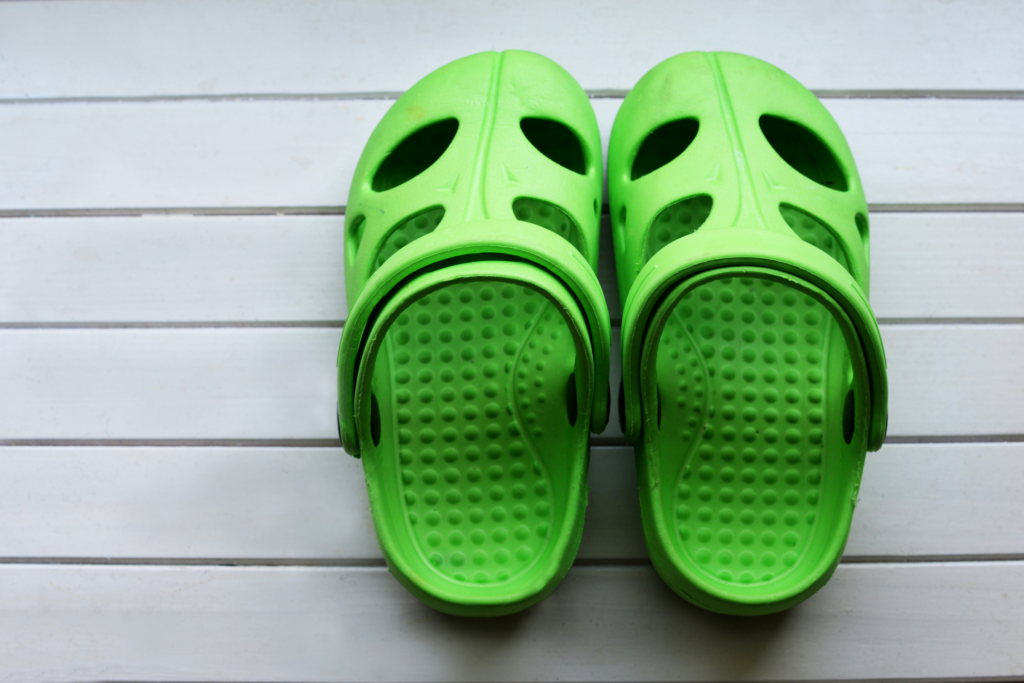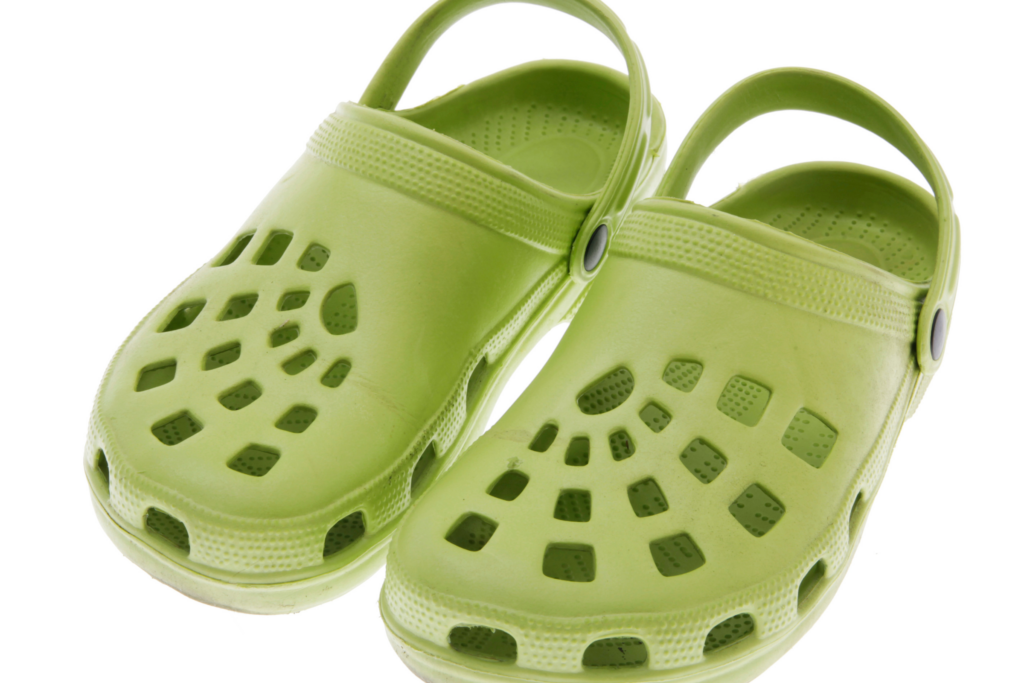Can You Spray Paint Crocs? (Step-by-Step How To & Fun Ideas!)
Crocs have gained popularity in recent years for their comfortable design and unique appearance. Their easily customizable nature has led many wearers to wonder if it’s possible to spray paint their favorite pair of Crocs.
Yes, you can spray paint Crocs and many people find that using a high-quality acrylic spray paint along with a simple preparation process (cleaning and lightly scuffing or sanding the Crocs) provides a longer-lasting look that is more resistant to cracks and wear.
Read on to learn more about the ins and outs of painting Crocs shoes, our recommendations for paint, and a thorough how-to guide!
How to spray paint Crocs (Step-by-Step Guide)
Before you begin spray painting your Crocs, proper preparation is essential to ensure that the paint adheres to the Croslite material and results in a durable, high-quality finish. In this section, we will cover the steps you need to take to prepare the surface of your Crocs for painting.
1. Clean up the Crocs and make sure there is no dirt or oil
The first step in preparing your Crocs for spray painting is to clean the surface thoroughly. Crocs are made from a comfortable and lightweight foam rubber material called Croslite, which can easily accumulate dirt and grime.
Start by removing any loose dirt or sand from the surface of the shoes. You can use a soft brush or cloth to do this. Next, mix a few drops of mild dish soap in a bowl of warm water and clean the entire surface of the Crocs using a sponge or a soft cloth. Make sure the shoes are free from any soap residue by thoroughly rinsing them under running water.
Finally, to remove any remaining grease or oil, wipe the surface down with rubbing alcohol and let the shoes air dry completely.

2. Scuff or lightly sand the surface of the Crocs for better paint adhesion
To help the paint adhere to the plastic surface of the Crocs, you should lightly sand the surface before painting. Sanding the surface will create a slightly rough texture, allowing the paint to stick to the Croslite material more effectively.
For this step, use a fine-grit sandpaper (around 220 to 320 grit) to gently sand the surface of the shoes, making sure to cover all areas that you plan to paint. Be careful not to sand too aggressively, as this can damage the foam rubber material.
Once you have finished sanding the shoes, use a clean cloth or a soft brush to remove any dust or debris left behind. Your Crocs are now ready to be spray painted, and you can follow your desired design to customize your comfortable shoes.

3. Choose the right kind of spray paint for your Cros
When it comes to customizing your Crocs with spray paint, there are a few key aspects to consider, such as the types of spray paint and their compatibility with Croslite material.
In this section, we will discuss these factors and guide you in making the right choice.
Spray paint options for Crocs
There are several types of spray paint available on the market, each with its own characteristics and use cases.
Let’s briefly discuss some of the most common types to help you determine the best option for painting your Crocs:
- Acrylic spray paint: Acrylic paint is a popular choice due to its durability and flexibility. It works well when applied to Crocs and is less likely to crack or fade compared to other paints. Additionally, acrylic paint is water-resistant, making it suitable for footwear. (source)
- Enamel spray paint: Enamel paints are known for their high-gloss finish and durability. While they may work on Crocs, they tend to be less flexible than acrylic paints, potentially leading to cracks or chips over time.
- Latex spray paint: Latex-based spray paints are less commonly used for painting shoes, as they may not adhere well to Croslite material and can be less durable than other options.
Before applying any spray paint to your Crocs, it’s important to prepare the surface by using light sanding or even a plastic primer. This will help the paint adhere better and result in a more even finish.
When purchasing spray paint for your Crocs, look for one that specifically mentions compatibility with plastic materials. This will ensure the paint adheres properly to the Croslite material and provides a long-lasting, quality finish. Experimenting with different colors and designs can be a fun way to personalize your footwear, so feel free to mix and match colors to create a look that reflects your unique style.
4. Come up with your design ideas
When it comes to customizing your Crocs, the possibilities are endless.
Explore your creative side by coming up with unique designs and patterns. Start by sketching your ideas with a marker on paper or using design software. This will help you visualize the final look and choose the right colors to achieve the desired effect. Remember to be confident and clear in your design choices.

5. Tape off your Crocs and prepare your work area
To create clean and precise patterns on your Crocs, masking tape is an essential tool. For simple patterns like stripes or geometric shapes, use painter’s tape to cover the areas you don’t want to paint. When applying the tape, make sure it’s pressed down firmly to prevent paint from bleeding through.
For more intricate designs, you can cut shapes or letters out of masking tape and place them onto the shoes. Be mindful of the spacing between the patterns to ensure a balanced look.
When the paint is dry, carefully peel off the masking tape to reveal your design. Finish the project by applying a waterproof sealer to protect your artwork and enhance its durability. Allow the sealer to dry for 24 hours before wearing your newly customized Crocs.

6. Paint your Crocs!
Once your design is taped up, it’s time to start painting. Apply acrylic paint in thin layers, and allow each layer to dry before adding more. Use a combination of brushes and sponges for better control and coverage.
To avoid smudging, always paint from the taped areas toward the edges of the shoe.
To achieve a high-quality finish and ensure the paint doesn’t crack or peel, it’s crucial to apply thin layers of paint.
- Spray the first layer: Holding the spray can about 10-12 inches away from the Crocs, apply a thin layer of paint using controlled, sweeping motions. Follow the contours and curves of the shoe to ensure even coverage.
- Allow paint to dry: Let the paint dry according to the manufacturer’s recommendations before applying subsequent layers.
- Apply additional layers: For optimal results, apply 2-3 more thin layers of paint, allowing each layer to dry before applying the next.
By following this spray painting technique, you can create a customized, fresh look for your Crocs while ensuring the paint lasts and withstands wear.
Remember to work in a well-ventilated area and take the necessary safety precautions when using spray paint materials.
Alternative ways to paint Crocs besides spray paint
While spray painting is a pretty quick and effective way to paint your Crocs shoes, it isn’t the only way!
You could also try:
- Brush painting with acrylic
- Hydro dipping
- Markers
Brush painting with acrylic
One popular option for customizing your Crocs is brush painting using acrylic paint. Acrylic paints are known for their durability and vibrant colors.
To achieve the best results, apply the paint in thin layers, letting each one dry before adding another. After you’re satisfied with the design, apply a waterproof sealer or varnish to protect the paint from water and wear.
Hydro Dipping
Hydro dipping is a creative and interesting technique for customizing your Crocs. Also known as water transfer painting, this process involves the following steps:
- Fill a large plastic bucket with water.
- Spray 1-4 colors of acrylic or latex paint on the water’s surface, creating a unique design.
- Carefully dip your Crocs into the water, ensuring that the entire shoe is submerged.
- Slowly remove the shoes from the water, allowing the paint to adhere to their surface.
- Let the Crocs dry completely before wearing them or applying a sealer.
Hydro dipping can create beautiful and unique patterns on your Crocs, with the added benefit of covering their holes evenly.
Markers
Another option for customizing your Crocs is using paint markers.
Paint markers offer greater precision than brush painting or hydro dipping, making them perfect for intricate designs or doodles. Make sure to choose markers that are compatible with the Crocs material (Croslite) and won’t fade or crack. After completing your design, seal the shoes with a waterproof sealer or clear resin to ensure long-lasting results.
Remember, with each of these alternative painting methods, always first clean and prep your Crocs before applying paint, and allow adequate drying time for both the paint and any sealants or varnishes.
Finishing and protecting painted Crocs
After you’ve successfully painted your Crocs, it’s important to finish and protect your new design to ensure its longevity.
In this section, we will discuss two methods to achieve this: using a clear acrylic sealer and adding a protective spray varnish.
Using a clear acrylic sealer
A clear acrylic sealer will help protect the paint on your Crocs from chipping, cracking, and fading. Before applying the sealer, make sure your painted Crocs are completely clean and dry. If needed, you can gently sand the plastic surface to create better adherence.
Apply a thin layer of the clear acrylic sealer to the entire surface of each shoe, focusing on the painted areas but also including the soles to ensure an even coating.
Allow the sealer to dry completely, which typically takes about 24 hours, before wearing your Crocs again. This will help protect your new design while maintaining the original comfort of the footwear.
Adding a protective spray varnish
Another option for protecting your painted Crocs is using a protective spray varnish. This method is especially helpful for those who have used acrylic paint or plastic primer spray in their painting process.
Make sure your Crocs are clean and dry before applying the varnish. Hold the spray can approximately 12 inches away from the shoes and apply a light, even coat over the entire surface, including the soles. Allow the varnish to dry completely, which can take a few hours depending on the product used.
A protective spray varnish will give your painted Crocs an additional layer of defense against common issues such as fading, chipping, or cracking, helping your craft project look fresh and vibrant for longer.
Protecting against wear and tear
Even though Crocs are made from durable Croslite material, painted surfaces may experience wear and tear over time. To minimize cracking and peeling, consider taking off your Crocs when walking in rough terrain or encountering heavy rain.
You can use a clear acrylic sealer to maintain the integrity of the paint. This protective layer keeps your white Crocs or those with fabric dye from fading and helps preserve the texture of the paint on the plastic surface.
Cleaning painted Crocs
Cleaning your painted Crocs properly is essential for maintaining their appearance. To clean them effectively, follow these steps:
- Remove any flair: If your Crocs have additional decorations, remove them before cleaning to avoid damaging the paint.
- Use a soft cloth: Gently wipe down the painted surfaces with a soft, damp cloth. Avoid using abrasive materials that could scratch or damage the paint.
- Avoid soaking: Submerging your painted Crocs in water may cause the paint to loosen, so avoid doing this. Instead, spot clean and wipe the shoes with a damp cloth.
- Dry properly: Air-dry your Crocs in a well-ventilated area, away from direct sunlight to prevent the paint from cracking or fading.
- Regular maintenance: Regularly check for any signs of peeling or cracking. If any issues arise, apply a thin layer of clear acrylic sealer to the affected areas to protect the paint.
By adhering to these care guidelines, your painted Crocs will remain in good condition, and their unique design will stay vibrant for an extended period.

Other fun ideas to consider when painting Crocs
Let your personality shine through by customizing your Crocs with a variety of materials and techniques.
Use a brush to apply thin layers of paint, creating intricate designs or bold colors that showcase your individuality. For an even more artistic touch, consider adding Croc-a-doodles, fun embellishments like gems or charms, to your freshly painted shoes.
Fabric paint is another effective medium for personalizing Crocs. It provides a flexible and durable finish, ensuring your artwork remains intact even as the shoes bend and flex during wear. Once the fabric paint has dried, apply a layer of spray varnish to seal and protect your design from the elements and daily wear.
Perhaps you’d prefer a more uniform color change? Using Rit dye in a plastic bucket, submerge your Crocs for a consistent and thorough dye job. This technique is especially effective for white Crocs, which will showcase the dye’s vibrancy.
No matter which method you choose, customizing your Crocs is a fantastic way to express your creativity and ensure your shoes embody your unique style. With a wealth of materials, tools, and techniques at your disposal, the options are endless for creating a truly one-of-a-kind pair of footwear.
Frequently asked questions about spray painting Crocs
What type of paint adheres best to Crocs?
Acrylic paint adheres well to the Crocs’ surface due to its flexibility and durability. It is essential to prepare the shoe surface by lightly sanding or using a plastic primer spray before applying paint. This helps the paint stick better to the Croslite material of the Crocs.
How can you properly dye Crocs?
Dyeing Crocs is not the same as painting. Dye penetrates the material, while paint coats the surface. To dye Crocs, a suitable dye product for plastic materials is needed. However, dyeing Crocs is not commonly recommended, as the Croslite material may not absorb the dye uniformly.
Is acrylic paint suitable for painting Crocs?
Yes, acrylic paint is suitable for painting Crocs because it doesn’t crack or fade when applied correctly. It is essential to prepare the surface and apply thin layers of paint to achieve a satisfying result.
Can you hydro dip Crocs using spray paint?
Hydro dipping Crocs using spray paint is possible. The process involves floating spray paint on water, dipping the Crocs in the paint, and sealing them with a clear protective coating. However, the results may vary, and it may be challenging to achieve a smooth and even finish.
Is it possible to dye Crocs with rit dye?
Rit dye is not the ideal option for dyeing Crocs since it is formulated for fabrics mainly. The Croslite material in Crocs may not absorb the dye effectively and could lead to uneven results.
Let Us Know How We’re Doing!
Did this expertly prepared resource answer your question?
Do you have another question about home maintenance, home improvement projects, home appliance repair, or something else?
Get more information, send in questions and keep the discussion going by contacting the I’ll Just Fix It Myself company customer service team at at 1-800-928-1490 or Email us at [email protected]
